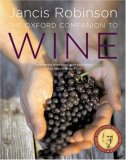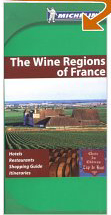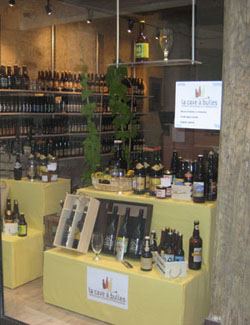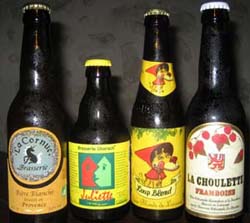Dr Vino's wine blog
wine talk that goes down easy
Tasting sized pours
Will the good conditions of 2006 spell relief for Bordeaux vineyard owners? Ironically, no. The Observer quotes Mathieu Barbier, a Bordeaux-based winegrower as saying: “Whatever we seem to do we get it in the neck. All the climatic conditions have been perfect and the grapes are magnificent… but the harvest is so large that prices are just going to dive again.” It’s a situation that means many vineyard owners may go bankrupt. [Observer; related “La double vie de barrique” Dr. V]
Looking for an NYC wine bar? The NYT travel section has a round-up of a few–including Bar Carerra (pictured), the site of the last Dr. Vino offline! See them all plotted on my map of NYC wine bars.
Do you ever wonder what it would be like to buy all the wine in your land? Beau gets the juice from the wine supremo in the control state of Utah. Beau’s first blogcast–congratulations! [Basic Juice]
Finland’s Agriculture Minister Juha Korkeaoja said the new EU wine refrom “was supported by just about all member countries.” Hmm, 25 countries total, but who might object? Perhaps the major wine producers who formed a Mediterranean alliance? [IHT via AP]
Taking a taxi home from the airport after a trip to wine country? Don’t advertise it if your home is Minneapolis where Somali taxi drivers are refusing to take passengers who are visibly carrying alcohol. [Upgrade: travel better}
UPDATE: Aoccording to Decanter.com, there are reports of heavy rains in Bordeaux, which might jeopordize the vintage (and save Barbier, above).
 tags: wine | wine travel | NYC wine
tags: wine | wine travel | NYC wine
Oxford Companion to Wine, third edition
 Jancis Robinson wrote over the weekend about the enormous effort it took to update the Oxford Companion to Wine. This third edition tips the scales at a whopping 840 pages, 6.57 pounds and 900,000 words. Many of the entries and material is new as she described in the Financial Times Weekend:
Jancis Robinson wrote over the weekend about the enormous effort it took to update the Oxford Companion to Wine. This third edition tips the scales at a whopping 840 pages, 6.57 pounds and 900,000 words. Many of the entries and material is new as she described in the Financial Times Weekend:
“France’s crise viticole is another quasi political entry and, with a certain neatness for students of the Oxford University curriculum, each of politics, philosophy and economics have for the first time their own wide-ranging entries on their implications for wine.”
Why is this excerpt so important? Because I authored the 1,000 word entry on the “politics of wine”! That’s right, I was honored to contribute 1/900th of the volume!
I haven’t seen the tome yet but there’s lots new and lots fresh in this edition. I’m already carving out a space on my desk–and structurally reinforcing it!
The book’s official release date is Oct 1 but it is available now through Amazon.
 tags: wine | wine books | Oxford Companion to Wine
tags: wine | wine books | Oxford Companion to Wine
Happy hour or profit hour?
It’s Friday and many people across the world will be heading out with co-workers for a drink this evening. Do you go out with your co-workers?
After listening to this NPR story, you might give it a shot. As they write on the Marketplace site, “A new study shows that workers who are open to staying after work for a drink with colleagues make more money — a lot more.” [NPR]
Hey, maybe there’s a similar effect with people who take my NYU evening classes? I’ll have to examine it. Then I could market it as better for your career than an MBA!
Blending innovation and tradition: can you taste the difference?
Sept 21 – Oct 19, 6:30 – 8:30
[disregard the course description on the NYU page–this is what we will be doing]
Organic foods and wines are all the rage. But can you taste a difference? In this introductory course, we will look at five exciting wine regions and examine the history and culture and some leading producers. We will discuss the pros and cons of “natural” winemaking versus conventional in the Pacific NW, Napa/Sonoma, Argentina, the Loire and Bordeaux. Then we will put our discussion to the test with a blind tasting of at least five wines, including conventional, organic and even biodynamic. Can you taste the difference?
 tags: wine | wine classes NYC | happy hour
tags: wine | wine classes NYC | happy hour
Book review: The Wine Regions of France
 Michelin, The Wine Regions of France
Michelin, The Wine Regions of France
A guide to cathedrals might seem like the logical shift toward themes for the Michelin green guides, traditionally organized by country or region. But I came across one with another theme: French wine regions.
On the whole the book offers the first time tourist a bird’s eye view. The first 70 pages provide a brisk overview of wine and France that is balanced and up-to-date enough to touch on the recent troubles of the French wine industry. In the subsequent twelve regional sections, each has a regional map with several itineraries laid out in typical Michelin style. Practical information ranges from select hotels and restaurants to good shops for wine and other regional products in the main towns.
However the major drawback is that the guide’s group author backs down from providing a star-ranking for the wine producers themselves. Michelin has no qualms about rating chefs, hotels, cathedrals, museums, indeed entire towns and villages in its other guides yet is unable to rate wine producers here either for the quality of their wines or the tourist appeal of their properties. Since many visits to wine country tend to be for a weekend or combined with other attractions in the area, such a ranking would provide the harried traveler a useful thumbnail sketch of the top wineries in the area. Suggesting a fun big name to visit as well as an independent grower that few might have heard of would be helpful way for a tourist to balance an afternoon. In Champagne, for example, why not offset the slick tour at Moet with a visit to Jacques Selosse whose extraordinary champagnes are not exported to the US.
Although it is a book of all wine producing regions of France, the tourist is probably only likely to visit one region. Thus the book must be evaluated on the strength of the regional coverage. It’s a pity then that the regional sections are too thin with too much material recycled from the regional green guide and not enough opinion and information satisfy the wine tourist. The maps indicate only a few winery locations among the other sites and hikes. While the unstarred winery blurbs do provide useful contact info and some visitor hours, their descriptions are often bland and not enough for the tourist to know what’s worth visiting.
Even if they pull their punches by not giving star reviews, that’s not the case here. I give the book one star, or “worth a browse.” In the end this book resembles Michelin’s thin rival guide, Zagat, since it is mostly useful for the contact information and hours (when correct).
 tags: wine | wine travel | France | Michelin guide
tags: wine | wine travel | France | Michelin guide
Charity tasting for Darfur
If you are going to contribute relief money to a war-torn region, would you simply write a check to a relief organization? Or would you blend in some fine wines?
Next week you can do both. For the first time in 12 years, the wines of the T Edward portfolio will be available under one roof for a consumer tasting. Thomas E. Byrne wrote me that “entirely all the proceeds go to Darfur.” The charity is the International Rescue Committee, which does work in the region (as well as Lebanon and the Congo).
The excellent wines include many organic producers and many excellent and hard-to-find wines:
The event will showcase fifty of T. Edward’s organically driven winemakers from Spain, France, Italy, Germany, Oregon, California, Washington, New Zealand, Australia, South Africa, Greece and Portugal. In total, over four hundred wines will be poured, including selections from ZD, Robert Sinskey, Vineyard 29, Jamey Whetstone, Titus, Dutton Goldfield, Tenuta di Trinoro, Allan Scott, Jean Luc Thunevin of Chateau Valandraud, Domaine de Montvac, Sybille Kuntz, and Tamarack.
Wednesday, August 23, 2006, 6-9 PM
Puck Building, at Lafayette and Houston.
Tickets are $100 and available through DiningForDarfur.com
 tags: wine | charity wine events | NYC
tags: wine | charity wine events | NYC
Rounding out and buying up
Consolidation has been one of the most noticeable trends in the wine industry of the past few years. Two of the juiciest morsels still privately held have just indicated their desire to get in on the M&A action. But instead of submitting to being bought, they are the ones doing the buying.
Jess Jackson, owner of Kendall-Jackson among other brands, has just emerged as the highest bidder for Legacy Estates, the bankrupt wine company that includes the premium brands Freemark Abbey winery in Napa Valley, the Arrowood Vineyards and Winery in Sonoma and the Byron Vineyard and Winery in Santa Maria. He has offered $97 million according to Wine Business Monthly but may have to pay a further $5 million to Wilson-Daniels, Legacy’s distributor, to get out of the prior distribution agreement. [WBM]
Roger Trinchero, vice-chairman and CEO of Trinchero Family Estates, announced the acquisition of Napa Cellars a small winery founded in 1996. [WBM] Napa Cellars offers wines around $25 retail, the low-end of Napa’s increasingly high price range.
The Trincheros struck gold in the late 1970s when they pioneered white zinfandel, which grew into the multi-million case brand of Sutter Home. As white zinfandel has softened, the privately held company has leveraged its bulk to acquire higher-end wine brands.
According to WBM, Trinchero was the sixth largest US winery last year with over nine million cases sold. Kendall-Jackson was eighth, selling five million cases. If you’re interested in seeing the biggest of the big, check out this informative article from Wine Business Monthly.
Are these companies rounding out their portfolios to be more attractive to potential suitors? Could be. Or they could be getting ready for the next generation of leadership with a slightly more diverse range of wines. Time will tell…
 tags: wine business | mergers & acquisitions
tags: wine business | mergers & acquisitions
Tasting sized pours
The NYT Sunday Business runs a long article today on numerical wine ratings, aka The Number. Consider it essential reading. I’ll be adding it to the syllabus of my critics class at NYU this fall since it provides a good overview of the contours of the debate.
The struggle to end Prohibition, which ended 73 years ago at the national level is still being fought at the county level. Yesterday, the NYT business section (again!) ran a story about the new push to make Dry counties in the south “wet.” The new forces behind the change are “…local and national business interests that stand to profit from the sale of alcohol, including real estate developers, grocery chains, restaurant groups and Wal-Mart, are combining their political and financial muscle to try to persuade hundreds of dry towns and counties to go wet.”
Eric Felton wrote a funny piece in yesterday’s WSJ entitled “When bad things happen to good tequila” and chronicles when alcohol brands are at the center of bad news stories, as was the case with a bottle of Cazadores tequila in Mel Gibson’s car. [$WSJ]
Teens don’t get around local liquor laws very often by buying wine and spirits on the web a survey showed. [USA Today]
If you thought worms were reserved for tequila, Australian scientists are studying them for their smell sensors–for wine. [Reuters]
And in Australia, growers with unprofitable vineyards have been urged to abandon them to help reduce the country’s glut. [Adelaide Now]
French microbrews
 What do you do when it is 97 degrees outside and there’s no AC? And combine that with stumbling on a new shop specializing in microbrews? There’s only one answer: comparative beer tasting!
What do you do when it is 97 degrees outside and there’s no AC? And combine that with stumbling on a new shop specializing in microbrews? There’s only one answer: comparative beer tasting!
Walking along a narrow street not far from the Pompidou Center (Beaubourg) I found La Cave a Bulles, which had a strategic location right across from the Belgian cultural institute. The gregarious and knowledgeable Simon Thillou opened the store on July 18th and he has hundreds of “artisanal” beers in stock, mostly from France but some from Belgium too. Simon said that 20 years ago there were only 20 beer producers in France but that today there are over 200. Sure, it’s not much compared to the number of microbreweries in the US, but it is still good growth.
So I put him to the test: give me four summer beers, two lagers, one white beer, and a fruit beer. This may seem kinda like trying to find the best burrito in France, but hey, the circumstances presented themselves.

Sadly, the results were not good. La Cornue from Provence, the biere blanche was not a blanche as some others I’ve had (e.g. Hoegaarden) and had some aromas that were distinctly unusual, if not off. Juliette, the first lager tasted artificial, like the fake scents of a cleaning solution (pine). Loup blond, which has a great label, was sort of cidery and the least offensive of the tasting. Hardly high praise. Finally, the framboise again tasted artificial, and didn’t cohere, like a mediocre lager with a shot of raspberry.
Perrier anyone? Despite these results, I would definitely go back and visit Simon again and try some more. After all, there are still 196 bottles of beer on his wall.
La cave a bulles, 45 rue Quincampoix, 75004 Paris tel: 01 40 29 03 69
 tags: beer | tasting notes | Paris beer stores
tags: beer | tasting notes | Paris beer stores



